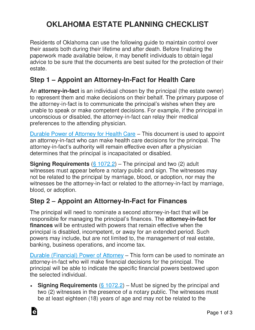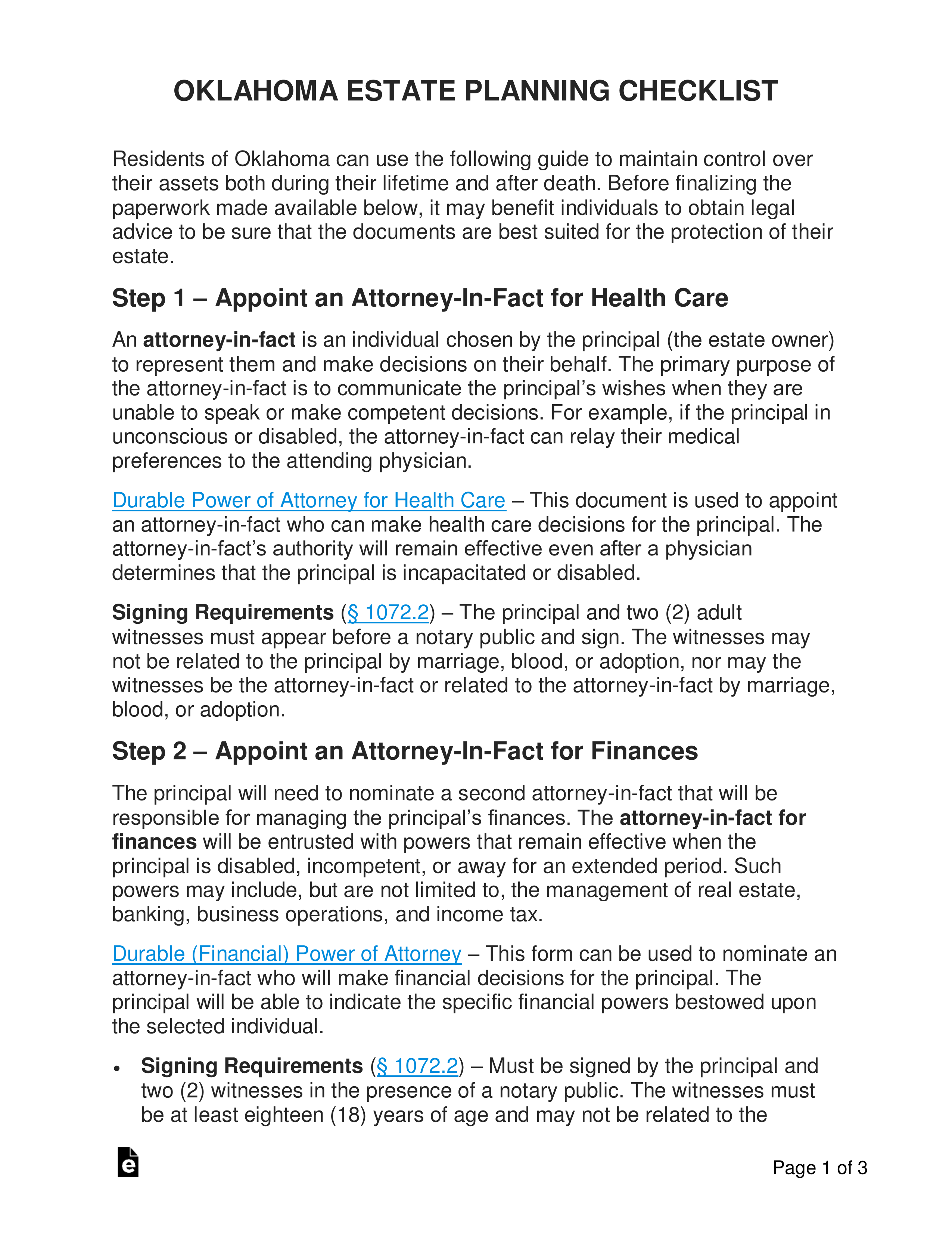Updated March 17, 2024
An Oklahoma estate planning checklist is a document designed to help residents know the steps they need to take to protect and distribute their assets after their death. Individuals can appoint representatives that will act on their behalf and make important decisions regarding finances and health care. The appointment of such representatives will be made via the completion of a Durable Power of Attorney for Health Care and Durable (Financial) Power of Attorney. After nominating the representatives, individuals will need to create a Living Trust or Last Will and Testament, both of which serve as blueprints for the distribution of one’s assets after death.
How to Create an Estate Plan in Oklahoma (6 steps)
- Appoint an Attorney-In-Fact for Health Care
- Appoint an Attorney-In-Fact for Finances
- Create Assets List
- Choose the Beneficiaries
- Decide How the Assets Will be Transferred
- Keep Estate Documents Safe
Residents of Oklahoma can use the following guide to maintain control over their assets both during their lifetime and after death. Before finalizing the paperwork made available below, it may benefit individuals to obtain legal advice to be sure that the documents are best suited for the protection of their estate.
1. Appoint an Attorney-In-Fact for Health Care
An attorney-in-fact is an individual chosen by the principal (the estate owner) to represent them and make decisions on their behalf. The primary purpose of the attorney-in-fact is to communicate the principal’s wishes when they are unable to speak or make competent decisions. For example, if the principal in unconscious or disabled, the attorney-in-fact can relay their medical preferences to the attending physician.
Durable Power of Attorney for Health Care – This document is used to appoint an attorney-in-fact who can make health care decisions for the principal. The attorney-in-fact’s authority will remain effective even after a physician determines that the principal is incapacitated or disabled.
Signing Requirements – The principal and two (2) adult witnesses must appear before a notary public and sign. The witnesses may not be related to the principal by marriage, blood, or adoption, nor may the witnesses be the attorney-in-fact or related to the attorney-in-fact by marriage, blood, or adoption.[1]
2. Appoint an Attorney-In-Fact for Finances
The principal will need to nominate a second attorney-in-fact that will be responsible for managing the principal’s finances. The attorney-in-fact for finances will be entrusted with powers that remain effective when the principal is disabled, incompetent, or away for an extended period. Such powers may include, but are not limited to, the management of real estate, banking, business operations, and income tax.
Durable (Financial) Power of Attorney – This form can be used to nominate an attorney-in-fact who will make financial decisions for the principal. The principal will be able to indicate the specific financial powers bestowed upon the selected individual.
- Signing Requirements – Must be signed by the principal and two (2) witnesses in the presence of a notary public. The witnesses must be at least eighteen (18) years of age and may not be related to the principal by marriage, blood or adoption, nor can they be the attorney-in-fact or related to the attorney-in-fact by marriage, blood, or adoption.[1]
Financial Powers Allowed
- Real Property Transactions;
- Tangible Personal Property Transactions;
- Stock and Bond Transactions;
- Commodity and Option Transactions;
- Banking and Other Financial Institution Transactions;
- Business Operating Transactions;
- Insurance and Annuity Transactions;
- Estate, Trust, and Other Beneficiary Transactions;
- Claims and Litigation;
- Personal and Family Maintenance;
- Benefits from Social Security, Medicare, Medicaid, or Other Governmental Programs, or Military Service;
- Retirement Plan Transactions;
- Tax Matters.
3. Create Assets List
4. Choose the Beneficiaries
5. Decide How the Assets Will be Transferred
The principal will need to draft a legal document that identifies the beneficiaries and describes the assets each party will inherit following the principal’s death. For this purpose, the principal must complete one (1) or both of the following:
Last Will and Testament (‘Will’) – This is the most widely used instrument that enables individuals to choose beneficiaries and describe the assets being transferred after death. After the principal dies, the form must go through probate to determine whether the document is in fact the last will and testament of the principal, and to present others with an opportunity to submit claims to recover debts. The probate process often results in additional fees and an extended administration period.
- Signing Requirements – The principal must sign or acknowledge the Will in the presence of two (2) attesting witnesses. Each witness must sign at the end of the Will in the principal’s presence.[2]
Living Trust (Revocable) – A Living Trust, once created, is an entity unto itself wherein the principal (grantor) can transfer the ownership of assets and property. A trustee will be required to manage the assets while the principal is alive (the principal and trustee are often the same person). The principal will nominate the beneficiaries of the assets in the same manner as a Last Will and Testament. However, unlike a Will, the Living Trust does not go through probate following the grantor’s death thus allowing the beneficiaries to receive their assets immediately.
- Signing Requirements – There are many ways to create a Living Trust. State law does not specify how the document must be signed. However, it is general practice to sign the document in the presence of a notary public and two (2) witnesses.[3]
6. Keep Estate Documents Safe
Oklahoma Estate Planning Laws
- Durable Power of Attorney for Health Care – Title 58, Chapter 17A
- Durable (Financial) Power of Attorney – Title 58, Chapter 17A
- Last Will and Testament – Title 84, Chapter 2
- Revocable Living Trust – Title 60, Chapter 4, Oklahoma Trust Act


